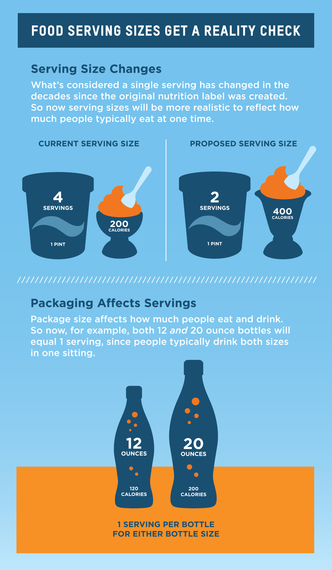Grocery shoppers, prepare to be a lot smarter about what goes into your basket.
And since what goes into your basket eventually goes into you and your family, this is truly great news for the health of our country.
The improvement stems from a makeover of the Nutrition Facts labels on food products, which was proposed recently by the Food and Drug Administration and announced by First Lady Michelle Obama. This will be the first overhaul since the labels were made mandatory in 1990.
A lot has changed since then in our understanding of diet and health. So think of this change as the labels finally catching up.
Details are still being ironed out. The FDA released two proposed options for the new labels, and will be gathering feedback until late May. Once the new format is settled, food makers will have up to two years to comply.
To understand what this all means to you, I'm turning this conversation over to one of our nation's foremost experts in this area: Dr. Alice H. Lichtenstein, who directs the Cardiovascular Nutrition Laboratory and is the Gershoff professor of Nutrition Science and Policy at Tufts University in Boston. Dr. Lichtenstein has been a member of the American Heart Association's Nutrition Committee since 1995, having also served as its Chair and Vice-Chair.
---
 Raspberry yogurt is one of those delightful items that both tastes good and is good for you. When it's time to buy a container, you might pull a couple off the shelf and scan the Nutrition Facts labels.
Raspberry yogurt is one of those delightful items that both tastes good and is good for you. When it's time to buy a container, you might pull a couple off the shelf and scan the Nutrition Facts labels.
That's when things can get tricky.
While each Nutrition Facts label lists an amount of total sugars, there's no way of knowing how much is natural (from the raspberries) and how much was added by the manufacturer.
Calories per serving are where you really have to pay attention. For instance, one company markets a package that contains two servings, and the label reads 90 calories per serving. The other company markets a package that contains a single serving with 120 calories. So which package has fewer calories? The one with 120 because the package that has 90 on the label is really equivalent to 180. This may not be apparent from a quick glance at the current label.
These ambiguities will soon be cleared up, a major breakthrough that the scientific community pushed for and is now applauding.
As great as it was when food labels were made mandatory in 1990 and implemented in 1993, they were based on recommended dietary allowances issued in 1968. So this update really was needed. Let's quickly go over some of the key changes coming to the roughly 700,000 food products that must carry these labels:
- Less emphasis on fat, more emphasis on calories -- This will be the easiest to notice because calories will now appear in a larger font. This prominence screams to consumers, "Pay attention to this!" And with two-thirds of Americans overweight or obese, that emphasis is exactly right. Additionally, say goodbye to the "calories from fat" line, an outdated concept now that we have a better understand about "good fats."
One version of the proposed label distinguishes which areas you want to consume more of (calcium, for instance) and which you want to limit (sodium). Regardless of how this plays out, it's a great reminder that to maximize the value of the proposed changes we'll need to teach consumers how to best use the information to improve their diets.
A real advantage will be the ability to make an informed choice between comparable products -- like two containers of raspberry yogurt or among different cracker options.
And if enough buyers make the healthier choice, manufacturers will notice -- especially the makers of the products that aren't being chosen.
Once food makers see what healthy products are selling, it's only logical that they will provide a wider range of healthier options, and that others will try catching up. Companies may even build advertising campaigns around it.
It also will be interesting to see how much reformulation companies may do with existing products now that they will be providing different types of information, particularly information they may not want to emphasize. Seemingly healthy products -- such as some of those raspberry yogurts -- may be unmasked as being closer to ice cream once they list added sugars.
To me, these changes could be the biggest benefit of the new labels. It will improve the default option. If industry embraces this opportunity, it can benefit, too, making it a real win-win all the way around.
Another opportunity for dramatic improvement is teaching youngsters to be Nutrition Facts label-readers. Once the new labels are finalized and introduced, I would love to see it turned into a curriculum for school children. Let's start raising smart shoppers -- an entire generation of consumers who consider it second nature to look for the healthier choices.
I'd like to close with some strategies shoppers can use now and again when the new labels are introduced.
- Study those serving sizes -- Figure out how much you are likely to consume before you even look at the calories. Because if you're going to eat twice as much as the serving size, you're going to have to double the calorie count.
More work remains to have heart-healthier eaters. But even the simple fact we're having this conversation shows we're headed in the right direction.
Alice H. Lichtenstein, D.Sc., is Director of the Cardiovascular Nutrition Laboratory at the Jean Mayer USDA Human Nutrition Research Center on Aging at Tufts University; Stanley N. Gershoff Professor of Nutrition Science and Policy at the Friedman School of Nutrition Science and Policy; and Professor of Medicine at Tufts University School of Medicine.


